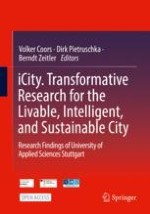This open access book presents the exciting research results of the BMBF funded project iCity carried out at University of Applied Science Stuttgart to help cities to become more liveable, intelligent and sustainable, to become a LIScity. The research has been pursued with industry partners and NGOs from 2017 to 2020. A LIScity is increasingly digitally networked, uses resources efficiently, and implements intelligent mobility concepts. It guarantees the supply of its grid-bound infrastructure with a high proportion of renewable energy. Intelligent cities are increasingly human-centered, integrative, and flexible, thus placing the well-being of the citizens at the center of developments to increase the quality of life. The articles in this book cover research aimed to meet these criteria. The book covers research in the fields of energy (i.e. algorithms for heating and energy storage systems, simulation programs for thermal local heating supply, runtime optimization of combined heat and power (CHP), natural ventilation), mobility (i.e. charging distribution and deep learning, innovative emission-friendly mobility, routing apps, zero-emission urban logistics, augmented reality, artificial intelligence for individual route planning, mobility behavior), information platforms (i.e. 3DCity models in city planning: sunny places visualization, augmented reality for windy cities, internet of things (IoT) monitoring to visualize device performance, storing and visualizing dynamic energy data of smart cities), and buildings and city planning (i.e. sound insulation of sustainable facades and balconies, multi-camera mobile systems for inspection of tunnels, building-integrated photovoltaics (BIPV) as active façade elements, common space, the building envelopes potential in smart sustainable cities).
